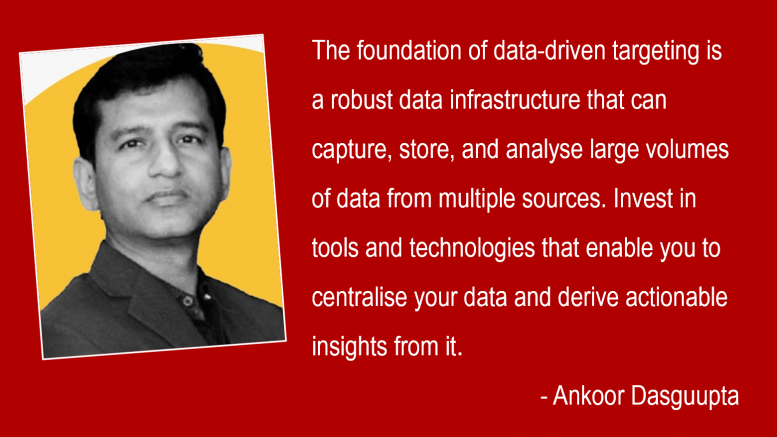In the dynamic landscape of marketing, one trend stands out as a game-changer which is the shift from traditional demographic segmentation to data-driven targeting. This paradigm shift is fuelled by the burgeoning information available to businesses today, allowing them to delve deeper into customer behaviours and preferences than ever before. I am excited to share some of my observations as to how this transformation is revolutionising strategies to empowering businesses deliver highly personalised experiences to their customers.
Gone are the days when marketers relied solely on broad demographic categories such as age, gender, and location to segment their audience. While demographic data certainly has its place, it often fails to capture the nuances of individual preferences and behaviours. Enter data-driven targeting—a methodology that leverages advanced analytics and machine learning algorithms to dissect vast datasets and uncover actionable insights about consumer behaviour.
So, how exactly does data-driven targeting enable highly personalised marketing?
Understanding Customer Behaviour at granular: By analysing data points such as purchase history, browsing patterns, social media interactions, and engagement with marketing campaigns, businesses can gain valuable insights into what motivates their customers and how they prefer to interact with brands. The thing is, this works best when the actionable insights are worked on consistently and having buy ins from internal stakeholders on the top 2 KPIs to measure.
Segmentation Based on Intent: Unlike demographic segmentation, which groups individuals based on static attributes, data-driven targeting focuses on segmentation based on intent. This means categorising customers according to their specific needs, preferences, and purchase intent at any given moment. For example, a customer who has recently browsed a selection of running shoes is likely to respond differently to marketing messages compared to someone who has been searching for hiking gear.
Hyper-Personalised Content: Armed with a deep understanding of customer behavior and intent, marketers can create hyper-personalised content that resonates with individual customers on a personal level. Whether it’s tailored product recommendations, personalised email campaigns, or dynamic website content, data-driven targeting allows businesses to deliver the right message to the right person at the right time. Just don’t be too intruding bombing by retargeting, be concerned 😊
Optimising Marketing Channels: Another key advantage of data-driven targeting is the ability to optimise marketing channels for maximum impact. By analysing which channels and touchpoints are most effective at driving engagement and conversions for different segments of their audience, marketers can allocate resources more efficiently and fine-tune their marketing strategies for better results.
Iterative Improvement: Data-driven targeting is not a one-time endeavour; it’s an ongoing process of iterative improvement. By continuously collecting and analysing data, businesses can refine their targeting strategies over time, adapting to changing consumer preferences and market dynamics to stay ahead of the curve.
Now, you might be wondering how your business can harness the power of data-driven targeting to supercharge your marketing efforts? Okay, so here I am with some steps –
Invest in Data Infrastructure: The foundation of data-driven targeting is a robust data infrastructure that can capture, store, and analyse large volumes of data from multiple sources. Invest in tools and technologies that enable you to centralise your data and derive actionable insights from it.
Implement Advanced Analytics: Leverage advanced analytics techniques such as machine learning and predictive modeling to extract meaningful insights from your data. Identify patterns, trends, and correlations that can inform your marketing strategies and drive better decision-making.
Collect Relevant Data: Focus on collecting data that is relevant to your marketing objectives and aligned with your target audience’s preferences and behaviours. This may include transactional data, website analytics, social media metrics, and customer feedback.
Segmentation and Personalisation: Use your data to segment your audience into distinct groups based on common characteristics or behaviours. Then, personalise your marketing messages and campaigns to speak directly to each segment’s needs and interests.
Test and Iterate: Don’t be afraid to experiment with different targeting strategies and messaging tactics. Use A/B testing and other experimental techniques to measure the effectiveness of your campaigns and iterate based on the results.
So, just to end this piece, understanding customer behaviour is not a one time effort, it is a cycle (not a vicious one though) that needs constant effort in driving from actionable insights of segmenting audiences based on intent, and leveraging advanced analytics, businesses can create hyper-personalised content, optimise marketing channels, and continuously improve their targeting strategies over time. Embrace the power of data sets and creativity together as data lead creativity is a good combination.
The views and opinions published here belong to the author and do not necessarily reflect the views and opinions of the publisher.



Be the first to comment on "Personalised Marketing for Customer-Centric Strategies"